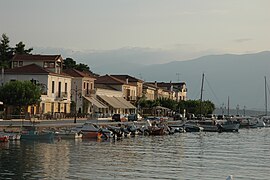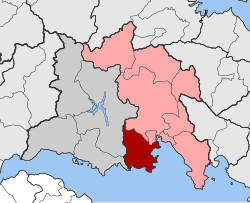Galaxidi
|
Galaxidi Γαλαξίδι |
|
|---|---|
 |
|
| Coordinates: 38°22′N 22°23′E / 38.367°N 22.383°ECoordinates: 38°22′N 22°23′E / 38.367°N 22.383°E | |
| Country | Greece |
| Administrative region | Central Greece |
| Regional unit | Phocis |
| Municipality | Delphi |
| • Municipal unit | 126.088 km2 (48.683 sq mi) |
| Elevation | 4 m (13 ft) |
| Population (2011) | |
| • Municipal unit | 2,989 |
| • Municipal unit density | 24/km2 (61/sq mi) |
| Community | |
| • Population | 2,011 (2011) |
| Time zone | EET (UTC+2) |
| • Summer (DST) | EEST (UTC+3) |
| Postal code | 330 52 |
| Area code(s) | 22650 |
| Vehicle registration | ΑΜ |
Galaxidi or Galaxeidi (Greek: Γαλαξίδι/Γαλαξείδι), is a town and a former municipality in the southern part of Phocis, Greece. Since the 2011 local government reform it is part of the municipality Delphi, of which it is a municipal unit. The municipal unit has an area of 126.088 km2.
Galaxidi has a small harbor on the north coast of the Gulf of Corinth. It is 7 km southwest of Itea, 15 km southwest of Delphi, 17 km south of Amfissa and 48 km east of Naupactus. The Greek National Road 48 connects Galaxidi with Naupactus, Itea and Delphi. Galaxidi is a 2.5h to 3h drive from the capital Athens and a relatively popular weekend retreat.
Modern Galaxidi is built on the site of ancient Haleion, a city of western Locris. Traces of habitation are discernible since prehistoric times with a peak in the Early Helladic Period (Anemokambi, Pelekaris, Kefalari, islet Apsifia). A significant Mycenaean settlement has been located at Villa; the hill of St. Athanasios also revealed a fortified Geometric settlement (ca. 700 B.C.). In the Archaic and Classical period (7th-4th centuries) was developed the administrative and religious centre at the modern site of Agios Vlasis. It seems that in ca 300 B.C. the present site was settled and surrounded by a fortification wall; it is the period of the expansion of power of the Aetolian League. Haleion flourished throughout the Hellenistic and Roman period until the 2nd century A.D.
From that period onwards there is no significant mention of the city until 981 A.D., when it was devastated by the Bulgarians. In the medieval period, Haleion was subjugated to the Villheardouins of Patras and subsequently to the Ioannite Knights. It is roughly in this period that the name was changed to Galaxidi, which, in 1446, came under Ottoman rule.
However, Ottoman presence in the village was only passing-by, the majority of the inhabitants consisting of Orthodox Christians. The city flourished due to the development of maritime trade in the 18th century. The commercial exchanges with the west, particularly for the agricultural products of Corinthia and the Corinthian gulf in general triggered the development of a local commercial fleet, taking advantage also of the exquisite natural port of Galaxidi. Particularly after the Treaty of Küçük Kaynarca (1774), many of the ship owners of Galaxidi operated under Russian flag. Despite their privileged position, the inhabitants joined immediately forces with the revolutionaries at the Greek War for Independence of 1821 and their city was destroyed twice by the Ottoman army, namely in 1821 and in 1825-6. It recovered, however, and in the course of the 19th century it thrived as a commercial and maritime centre, a fact attested also by the spacious and luxurious houses of the traditional settlement.
...
Wikipedia


